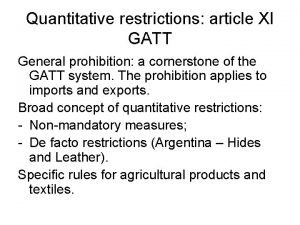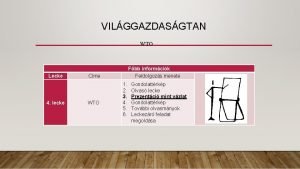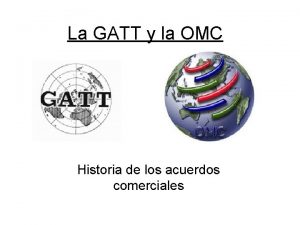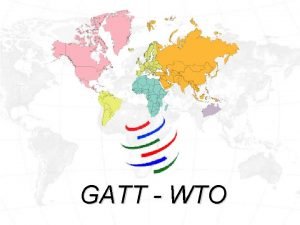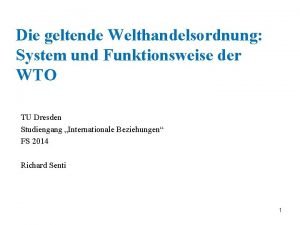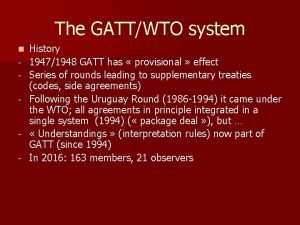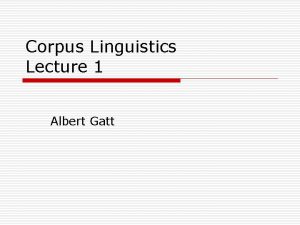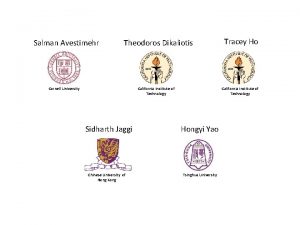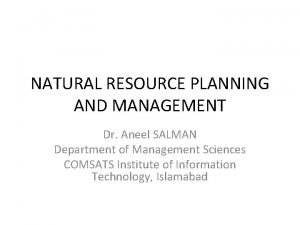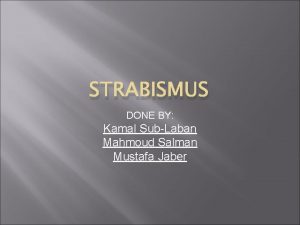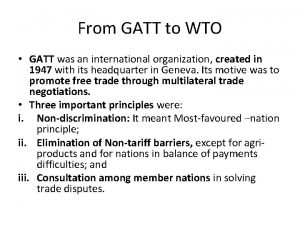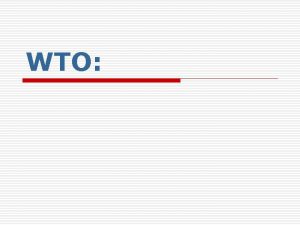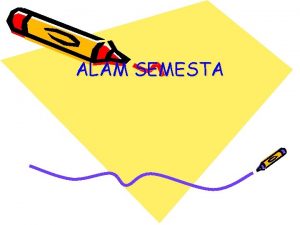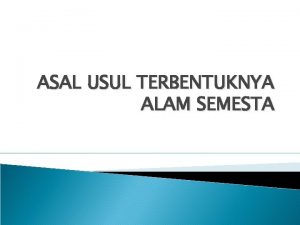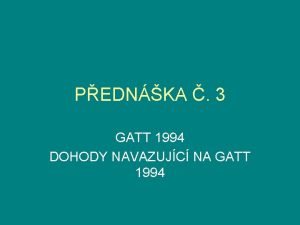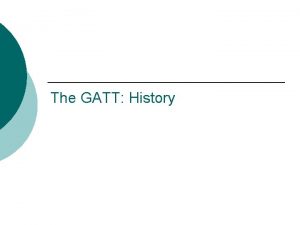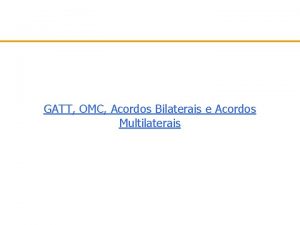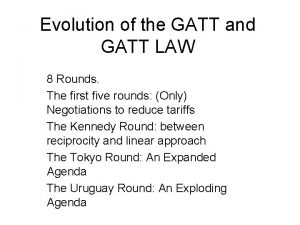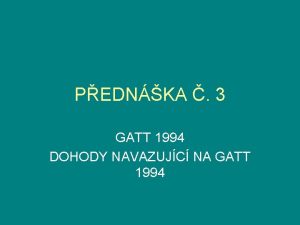Introduction To WTO GATT Lecture 2 Salman Alam

















- Slides: 17

Introduction To WTO & GATT Lecture : 2 Salman Alam Khan

General Agreement on Tariffs and Trade (GATT) � It was negotiated during the UN Conference on Trade and Employment and was the outcome of the failure of negotiating governments to create the International Trade Organization (ITO). � GATT was signed in 1947 and lasted until 1993, when it was replaced by the World Trade Organization in 1995. � GATT is a multilateral agreement regulating trade among 153 countries

GATT stands for: � The “General Agreement on Tariffs and Trade” (GATT) covers international trade in goods. � The workings of the GATT agreement are the responsibility of the Council for Trade in Goods(goods council). � The Goods Council has 10 committees dealing with specific subjects (such as agriculture, market access, subsidies, anti-dumping measures and so on).

Purpose of GATT: According to its preamble, the purpose of the GATT is the "substantial reduction of tariffs and other trade barriers and the elimination of preferences, on a reciprocal and mutually advantageous basis. "

WHY was GATT Replaced By WTO? �GATT rules applied to trade only in merchandise goods. �GATT dispute settlement system was slow. �GATT was just provisional agreement.

Introduction of WTO � World Trade Organization (WTO) was established on 1 st January 1995. � It is the only global international organization dealing with the rules of trade between nations. � The WTO (World Trade Organization) is an association of 146 member countries, of the 190 countries in the world today. There another 30 countries that have observer status, a step that precedes becoming a full-fledged member. � So almost all the countries in the world are members. There all types of countries in the WTO, capitalist, socialist, rich and poor countries, very industrialized and also developing countries.


Structure: �Ministerial Conference The topmost decision-making body of the WTO is the Ministerial Conference, which has to meet at least every two years. �It brings together all member of the WTO, all of which are countries or separate customs territories.

Councils for Trade �The Councils for Trade work under the General Council. �There are three councils-Council for Trade in Goods, Council for Trade-Related Aspects of Intellectual Property Rights, and Council for Trade in Services.

Members � 152 countries are the members of WTO. �The green sections are WTO member countries. �Ukraine became the newest member on May 16, 2008.

System: �Every membership countries can join hearing of an appeal, Dispute-Solution organization. �There are six formal Structures in WTO. �Every council opens every two years.

Objective of WTO �Raising standard of living & income. � Promoting full employment �Expanding production & trade, and optimum utilization of resources. �Introduce sustainable development �Promoting trade flows. �Establish procedures for solving trade dispute among members.

Basic principles of WTO: 1. Non – discrimination: ü This principle is based on the concept of normal trade relations-previously called most favored nation(MFN). ü This rule required that het WTO members extend the same favorable terms of trade to all the member that they will extend to any single member.

Basic Principles: 2. Transparency : ü It is the pillar of WTO. All members are required to publish their trade regulations , -To establish & maintain administrative decisions affecting trade. -To respond to the information by other members and to notify changes in trade policies to WTO.

Basic Principles: 3. Binding & Enforceable Commitments: In WTO, when countries agree to open their market for goods and services, they bind their commitments. 4. Reciprocity : It operates during negotiations with the objective of obtaining mutually beneficial arrangements through reciprocal reduction in tariffs binding.

Functions of WTO: �Administrating & implementing the multilateral & plurilateral trade agreements which make up the WTO; �Acting as a forum for multilateral trade negotiation; �Seeking to resolve dispute; �Overseeing national trade policies; �Cooperating with other institutions involved in global economic policy-making.

Thank You!
 Business environment
Business environment Prohibition of quantitative restrictions
Prohibition of quantitative restrictions Gatt logo
Gatt logo Gatt alapelvek
Gatt alapelvek Historia del gatt
Historia del gatt Uklad gatt
Uklad gatt Gatt abkommen
Gatt abkommen History of wto
History of wto Gatt logo
Gatt logo Albert gatt
Albert gatt Urban torhamn
Urban torhamn 01:640:244 lecture notes - lecture 15: plat, idah, farad
01:640:244 lecture notes - lecture 15: plat, idah, farad Ahmed salman rushdie
Ahmed salman rushdie Salman avestimehr
Salman avestimehr Natural gender
Natural gender Salman arain md
Salman arain md Idrees farooq fiverr
Idrees farooq fiverr Dr mahmoud salman
Dr mahmoud salman

